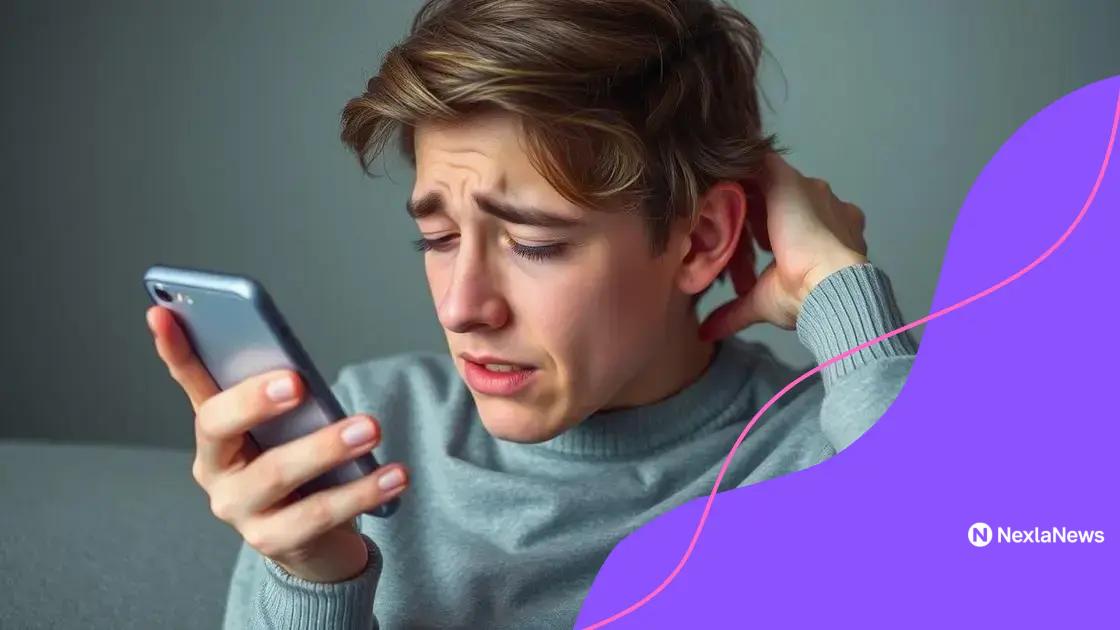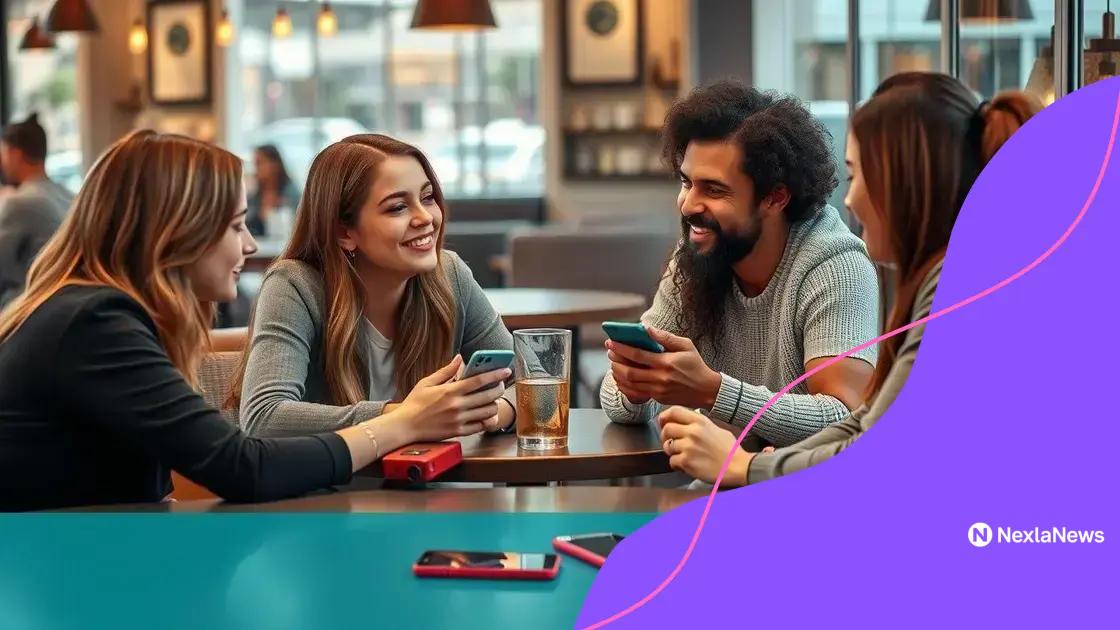Social media harms: understanding the negative impacts

Finding balance in social media usage is crucial for mental health; it involves setting time limits, engaging in offline activities, curating your feed, and taking regular breaks to foster a healthier relationship with technology.
Social media harms can be more prevalent than we think. Have you noticed how often we scroll through those platforms? Join me as we explore the less discussed consequences that come with social media use.
Understanding social media harms
Understanding social media harms is essential in today’s digital world. With billions of users worldwide, the impacts of social media platforms extend beyond simple interactions. They can heavily influence our daily lives, mental health, and relationships.
What Are Social Media Harms?
Social media harms refer to the negative effects that arise from using these platforms. These can be emotional, psychological, or social. Researchers have identified various issues, such as increased feelings of loneliness and depression.
Mental Health Effects
Many studies show that heavy social media use can lead to serious mental health issues. This includes higher rates of anxiety and depression. It’s important to recognize how social media harms can affect our well-being.
- Comparison culture increases stress.
- Cyberbullying can have lasting effects.
- Fear of missing out (FOMO) worsens anxiety.
These factors create a cycle that can be hard to break. Users often find themselves caught in a loop of validation seeking and negative emotions. They may feel included online, yet isolated in their daily lives.
Social Connections
Social media allows us to connect easily, but it can also weaken actual relationships. People often rely on online interactions instead of face-to-face conversations. This can lead to shallow connections that lack depth.
Moreover, the constant need for online approval can distort our self-image. We may start to define ourselves based on likes and shares, which is unhealthy.
Finding Balance
To minimize social media harms, it’s vital to find a balance. Limiting screen time can help preserve mental health. Consider setting specific times to check your accounts. Engaging in real-life activities can also enhance your mood and foster healthier connections.
Mental health effects of social media
The mental health effects of social media are quickly becoming a topic of major concern. Many users are unaware of how their online habits can impact their emotional well-being. Social media often creates a false sense of reality, which can lead to feelings of inadequacy and anxiety.
Impact on Anxiety and Depression
Research has shown that there is a direct link between heavy social media usage and increased rates of anxiety and depression. Comparing our lives to curated images online can make us feel inferior. The more we scroll, the more we might feel that we’re missing out, leading to heightened anxiety.
- Constant notifications can lead to stress.
- Seeing others’ highlights can worsen self-esteem.
- Engagement in toxic discussions may contribute to feelings of hopelessness.
Moreover, many users report feeling overwhelmed by the relentless flow of information. This can contribute to a sense of mental fatigue, making it important for individuals to be mindful of their social media consumption.
Coping Mechanisms
Finding ways to cope with these negative effects is crucial. Limiting social media use can significantly improve one’s mood. Taking breaks can help restore mental clarity and reduce stress. Consider spending more time engaging in face-to-face interactions and hobbies that don’t involve screens.
Additionally, unfollowing accounts that trigger negative emotions can create a more positive online environment. Curating your feed to include supportive and uplifting content can help mitigate the harms associated with social media.
Understanding Emotional Triggers
Identifying what triggers negative emotions on social media is key. Ask yourself, “What posts make me feel bad?” By pinpointing these moments, you can take steps to avoid them. Self-awareness is critical in maintaining a healthy relationship with social media.
Social media and relationships

Social media and relationships are intertwined in complex ways. While these platforms can help us connect with others, they also pose challenges. Effectively navigating this landscape is key to maintaining healthy relationships.
Positive Aspects of Social Media
Social media can enhance relationships by keeping us in touch with friends and family. It provides an easy way to share life updates and special moments. For many, especially those living far apart, it fosters a sense of closeness.
- Users can easily communicate across long distances.
- Sharing experiences can strengthen bonds.
- It allows for group interactions through chats and events.
Many people find comfort in online support groups. These communities connect individuals who share similar interests or experiences, providing a sense of belonging.
Challenges in Online Relationships
However, social media can also complicate relationships. Miscommunication is common online. Without face-to-face interaction, tone and intention may be misinterpreted. This can lead to conflict and misunderstandings.
Moreover, the comparison trap often appears. People tend to post their best moments online, causing others to feel inadequate. This can harm self-esteem and lead to feelings of isolation, even when surrounded by friends.
Balancing Online and Offline Interaction
Striking a balance between online and offline interactions is crucial. Spending too much time on social media can detract from real-life connections. It’s important to prioritize face-to-face conversations and activities.
Digital detoxes can help refresh perspectives. Take breaks from social media to engage in hobbies or spend time with loved ones. By doing so, you can reconnect with your support network in meaningful ways.
The impact of cyberbullying
The impact of cyberbullying is a growing concern in our digital society. This form of bullying takes place online and can affect individuals of all ages. It is important to understand how cyberbullying occurs and its consequences.
Understanding Cyberbullying
Cyberbullying involves using technology to harass, embarrass, or intimidate someone. It can happen through various platforms like social media, messaging apps, and online games. Victims often feel trapped, as the online harassment can follow them wherever they go.
- Harsh comments can damage self-esteem.
- Spreading rumors can lead to severe stress.
- Victims may experience social isolation.
As a result, many individuals suffer from emotional pain and anxiety. Sometimes, the struggles lead to more serious issues like depression or self-harm.
Signs of Being Affected by Cyberbullying
Recognizing the signs of cyberbullying is crucial for early intervention. Some behaviors may indicate that someone is a victim. Look for changes in mood, withdrawal from friends, or avoidance of online activities.
Open conversations about online experiences can help individuals feel supported. Encouraging open communication can create a safe space for victims to share their difficulties.
Combating Cyberbullying
Fighting against cyberbullying is essential. Schools and communities need to create awareness programs to educate users about its effects. Promoting kindness and respect online can change the digital landscape.
Setting boundaries on online interactions and reporting harmful behavior can empower individuals. Encouraging users to block bullies and seek help when needed fosters resilience.
Finding balance in social media usage
Finding balance in social media usage is vital for maintaining mental health and well-being. With so many platforms available, it can be easy to lose track of time online. Setting boundaries helps in creating a healthier relationship with social media.
Establishing Time Limits
One effective way to find balance is to establish time limits for social media use. Many apps now offer features to track and restrict usage. By setting daily limits, you can ensure you have time for other activities.
- Use apps that monitor screen time.
- Set specific times for checking social media.
- Consider using a timer to keep track of usage.
By staying aware of how much time you spend online, you can make more informed choices about your social media habits.
Engaging in Offline Activities
Incorporating offline activities into your daily routine is essential. Hobbies such as reading, sports, or outdoor activities can provide a break from screens. Connecting with friends and family in person reinforces real-life relationships.
Finding joy in offline experiences can help reduce dependency on social media. Try scheduling regular outings or setting aside time for creative activities without screens.
Curating Your Feed
Another way to find balance is by curating your social media feed. Follow accounts that inspire or motivate you, and unfollow those that cause stress or negativity. A positive online environment can enhance your experience and improve your mental health.
Remember, it’s okay to take breaks from social media. Digital detoxes can provide perspective and help reset your habits. Use this time to reflect on what social media means to you and how it fits into your life.
In conclusion, finding a healthy balance in social media usage is essential for mental well-being and strong relationships. By setting limits, engaging in offline activities, and curating your feed, you can create a positive digital environment. Remember to take breaks and prioritize real-life connections. This approach will help you enjoy the benefits of social media while minimizing its harms. Strive for balance and harmony in your online and offline life!
FAQ – Frequently Asked Questions About Social Media Balance
How can I set time limits for social media?
You can use apps or built-in features on your devices that track and restrict your social media usage to help manage your time.
What offline activities can I engage in to reduce social media use?
Consider taking up hobbies like reading, sports, or spending time outdoors with friends and family to distract from screen time.
Why is curating my social media feed important?
Curating your feed helps create a positive environment, reducing exposure to negative content, which can improve your mental health.
How often should I take breaks from social media?
It’s advisable to take regular breaks, such as daily or weekly, to recharge and reconnect with offline activities and relationships.
